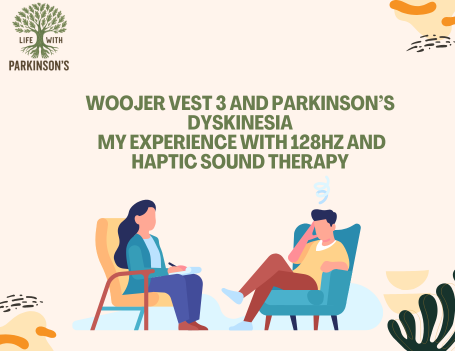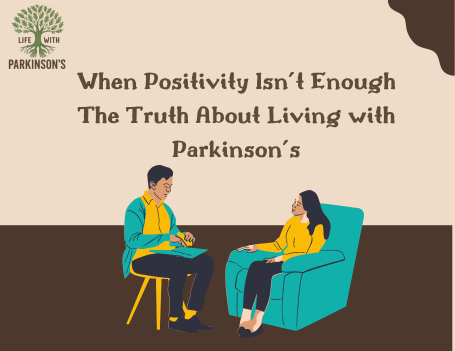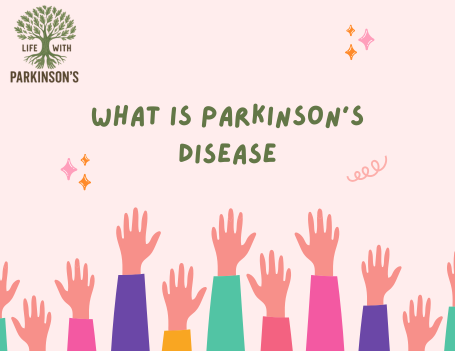For Parkinson’s Awareness Month, I had the opportunity to sit down and talk with Charlotte, who runs The Owl YouTube channel. Like me, she shares her life and experiences living with Parkinson’s disease. Over time, we’ve supported each other’s ventures on YouTube, and when we talked about collaborating, it felt like the perfect way to raise awareness and show others that they’re not alone on this journey.
In this post, I want to share the essence of our conversation — two people with Parkinson’s, reflecting on our diagnoses, challenges, and the ways we’ve both learned to adapt and live meaningful lives despite the disease.
Discovering Parkinson’s: How It All Began
Charlotte and I began our chat by revisiting those early, confusing moments — the first signs that something wasn’t quite right.
For me, it started with a slight tremor in my right thumb. I brushed it off for almost a year before bringing it up during a routine physical. My doctor noticed it too, and after checking for “cogwheeling” — that distinctive stiffness in the arm — he referred me to a neurologist.
She ran an MRI, did a few field-like tests, and eventually had me try carbidopa-levodopa. That’s when the diagnosis became clear: Parkinson’s disease.
I still remember the shock. I even had to ask her to stop talking because I couldn’t process what she was saying. In that moment, it felt like everything stopped — as though life had suddenly shifted beneath me.
Charlotte’s story was similar in many ways, though her symptoms started differently. She’d been feeling fatigue, stiffness, and rigidity for years while juggling work and family life.
People often assumed she’d injured her back or neck because her shoulders looked uneven. Her family doctor eventually noticed the stiffness and referred her to a neurologist too — and that’s when the puzzle pieces began to fit.
We both agreed that Parkinson’s can be incredibly confusing to diagnose. There’s no single blood test or scan that confirms it — it’s mostly a process of ruling everything else out. And because the symptoms vary so widely — from tremors to stiffness, from fatigue to sleep disturbances — it’s no wonder so many people spend years searching for answers.
No One-Size-Fits-All
One thing we both wanted to emphasize is that Parkinson’s doesn’t look the same for everyone. There’s no universal roadmap or timeline.
Some people experience tremors, others don’t. Some progress quickly, while others live decades with mild symptoms. There’s also a huge range of non-motor symptoms — things like constipation, loss of smell, vivid or disturbing dreams, and even REM sleep behavior disorder.
Charlotte shared how she used to have terrifying dreams — the kind you’d never think were related to Parkinson’s. I could relate. For both of us, these odd and often unrelated symptoms were clues we only recognized in hindsight.
This unpredictability makes awareness crucial. Too often, people — even those whose parents had Parkinson’s — don’t recognize the symptoms early. And that’s something we both hope to change by talking openly about our experiences.
Diagnosis at Different Ages
I was diagnosed at 44. Charlotte was 51. Both of us were still working and raising families when Parkinson’s entered our lives.
That timing made support harder to find. Most local support groups were filled with retirees and met during weekday mornings. When you’re in your 40s or 50s and still trying to balance work, family, and responsibilities, it can feel like there’s no place that fits.
Charlotte mentioned how she’d look for evening or weekend groups and find none. I experienced the same — a lack of age-appropriate spaces for younger people with Parkinson’s.
It reminded us how important it is for communities to build support networks that reflect the diversity of people living with this disease. Parkinson’s doesn’t just touch one demographic; it affects people of all ages, backgrounds, and lifestyles.
Awareness: Beyond “An Old Man’s Disease”
We both laughed — a bit ruefully — about how many of us once thought Parkinson’s was “an old white man’s disease.”
That perception is still common, but it’s not true anymore. Parkinson’s now affects younger populations, and increasingly, women.
Charlotte and I both know people in their 30s and 40s who’ve been diagnosed, and she even mentioned reading about a 12-year-old girl with the disease. It’s shocking — and it shows just how much more awareness is needed.
Environmental factors also came up. I know someone who developed Parkinson’s after using pesticides like Roundup in their orchard. My own grandfather had Parkinson’s too, and he was a tobacco farmer. I’ve taken genetic tests and learned that mine isn’t hereditary — it’s environmental. Sometimes I joke that I just “drew the short straw.”
But jokes aside, these connections matter. The more we talk about them, the better we can advocate for prevention, research, and understanding.
The Role of Caregiving and Support
We spent a good part of the discussion talking about caregiving, because it’s one of the most important — and least talked-about — parts of living with Parkinson’s.
I told Charlotte that I often say to my wife, “If I didn’t have you, what would I do?”
Parkinson’s isn’t something you face alone. It takes a village.
Charlotte agreed, sharing how her husband and family have been incredibly supportive. Her friends even check in on both of them — not just her, but also her husband, recognizing that caregivers need care too.
That’s something we both feel strongly about: care partners often lose themselves in the process of caring for us. They give so much of their energy and attention that they forget to recharge. Parkinson’s might affect one person physically, but it touches everyone emotionally.
“On” and “Off” Periods
Another shared experience is dealing with “on” and “off” periods — when medication is working smoothly versus when it wears off.
For me, when I’m “on,” I feel clear-headed, capable, almost like my old self. But when I’m “off,” even simple decisions can feel impossible. Sometimes I’ll ask my wife, “Is this a good idea?” and she’ll gently say, “Maybe wait until your meds kick in.”
Charlotte described something similar — struggling with comprehension and multitasking. She used to be able to juggle a hundred tasks at once, but now, things can feel overwhelming.
These shifts can happen several times a day, making it hard to plan or predict energy levels. Both of us have learned to prioritize, pace ourselves, and accept that what we get done in a day is enough.
Anxiety, Self-Management, and Learning Boundaries
For me, anxiety has been one of the hardest symptoms to manage. It often dictates how long I can socialize or how much I can commit to in a day.
I’ve had to set boundaries — deciding how long I can meet someone for coffee, or how many tasks I can realistically do in a day. I’ve learned to say no, to put my health first, and to stop feeling guilty for it.
Charlotte’s working on similar things. She’s fiercely independent but learning to ask for help more often. She also mentioned that she’s still figuring out her medication’s timing — knowing when she’s most “on” during the day.
We both agreed that self-management is a skill that takes time. It’s a constant balancing act between pushing yourself and knowing when to rest.
Pets, Companionship, and Limitations
At one point, we talked about pets — and this part hit home for me.
Those who follow my channel know about Kiwi, my little bird. She’s part of our family, and believe it or not, she senses when I’m “off.” For a while, she was anxious and even aggressive during those times, but my wife and I worked on retraining her. Now, Kiwi’s calmer and seems to understand when to give me space.
Birds are incredibly intelligent — sometimes it feels like she’s the one running the household.
Charlotte shared her own love of animals. She’s had everything from rabbits and geese to cats and dogs over the years. But lately, she’s hesitant about getting another pet. She worries about tripping hazards and whether she’ll have the physical strength to care for an animal long-term.
It’s a tough reality. Pets bring companionship and joy, but they also require energy — something we can’t always count on having.
Living with Parkinson’s as a Woman
Charlotte opened up about what it’s like managing Parkinson’s as a woman. She’s often been the one hosting family events, cooking holiday meals, and organizing gatherings.
She described spending all day in the kitchen for Thanksgiving — cooking, hosting, and cleaning late into the night. It’s rewarding but exhausting. She wonders how long she’ll be able to keep up those traditions.
Travel is another challenge. She and her husband love visiting national parks and hiking, but they know there will come a time when those trips will need to change. They’ve already started planning alternatives — maybe cruises or more relaxed forms of travel when the time comes.
Her openness reminded me how Parkinson’s touches every aspect of life — from mobility and stamina to traditions, hobbies, and even identity.
The Birth of Our YouTube Channels
Eventually, our conversation turned to something brighter — how we both started our YouTube channels.
My son actually started Life With Parkinson’s for me back in 2017. We couldn’t find many real-life stories from regular people living with the disease — just medical experts and celebrities. Those voices are important, but we wanted to see everyday life.
So, he opened the channel, filmed my first video, and uploaded it himself. I remember saying, “YouTube won’t last.” I couldn’t have been more wrong.
Today, the community that’s grown around that channel is one of the greatest blessings in my life. The relationships I’ve built and the people I’ve met from around the world — that’s what keeps me going.
Charlotte started her channel around the same time, for similar reasons. She wanted to encourage others to stay active and positive after diagnosis. She saw too many people feeling isolated and hopeless, and she wanted to change that.
She said it beautifully: “I’m your average 50-year-old woman living with Parkinson’s. I hope that makes me relatable.”
We both believe that the world needs all kinds of voices — from everyday people like us to researchers, doctors, and advocates. Everyone plays a role in raising awareness and offering support.
Paying It Forward
We also talked about what we want to give back. For me, I’ve said that if my channel ever reaches monetization (1,000 subscribers and 4,000 watch hours), I plan to donate 50% of ad revenue to Parkinson’s research.
Charlotte’s doing her part too — creating videos that motivate, educate, and bring people together.
Hearing her say that she’s inspired by my work was incredibly humbling. But really, it’s a shared effort. Every time someone comments, shares their story, or reaches out for support, it reminds me that this community is alive and thriving.
The Heart of It All
By the end of our conversation, we both realized how much ground we had covered — diagnosis, progression, caregiving, emotional struggles, lifestyle changes, pets, community, and hope.
The underlying message we wanted to leave people with was simple but powerful: You are not alone.
There’s strength in community, healing in connection, and hope in honesty.
This journey isn’t easy — for those of us with Parkinson’s or for our loved ones — but sharing our stories helps others see that it’s possible to keep moving, keep smiling, and keep living.
Support & Acknowledgments
I want to thank Charlotte for joining me in this open and heartfelt discussion. Her honesty, strength, and compassion are inspiring.
If you haven’t already, visit her channel The Owl — and check out our collaborative video there or on Life With Parkinson’s.
Final Thoughts
I often say that living with Parkinson’s is like learning to live life in a new rhythm. Some days are fast, others slow. Some days you soar, others you stumble. But every day, you keep going.
Talking with Charlotte reminded me of why I started this journey in the first place — to show that even in the face of Parkinson’s, life is still worth living fully.
So, to everyone reading this:Stay positive. Keep moving. And let’s take this journey together.
Support My Journey
If you’ve found value in my writing or the conversations I share, I’d be deeply grateful for your support. Every bit helps me continue producing content that raises awareness, connects people, and brings hope to those living with Parkinson’s and their loved ones.
You can support my work through Ko-fi — it’s a small way to help keep this mission going, one story and one conversation at a time.
A Note from Me
Every interview, every story, and every shared experience reminds me why I started Life With Parkinson’s in the first place — to connect, to understand, and to remind each other that we’re not walking this path alone.
Talking with people like Charlotte always grounds me in that truth. Awareness isn’t just about statistics or medical breakthroughs — it’s about real lives, lived courageously, day by day.
So thank you for being here, for reading, and for keeping these conversations alive. You’re part of a growing community that believes in compassion, understanding, and action.
Caregiver’s Corner
If you’re a caregiver, I want to take a moment to acknowledge you. You are the quiet strength that holds so much together. Charlotte and I talked about how caregivers often put their own needs aside — yet your patience, love, and resilience are what make life with Parkinson’s more livable for so many of us.
Please don’t forget to care for yourself, too. Rest when you can, talk when you need to, and reach out for help without guilt. You’re not invisible here — you are seen, valued, and deeply appreciated.
Medical Disclaimer
The information shared in this post reflects personal experiences and perspectives from my conversation with Charlotte. It is not intended as medical advice or a substitute for professional diagnosis or treatment.
Always consult with a qualified healthcare provider regarding any medical condition, treatment options, or changes in your care plan.



